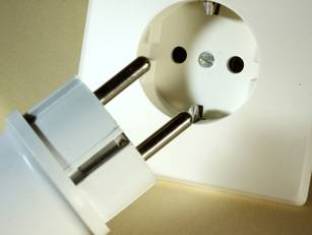Categories: Featured Articles » Electrician at home
Number of views: 10550
Comments on the article: 1
How to safely operate home electrical wiring with household appliances
 A person with his senses cannot perceive:
A person with his senses cannot perceive:
-
the rustle of electrons traveling through wires;
-
see the speed of their movement;
-
smell them.
We cannot detect electrical energy without special devices, but it can cause great harm to our body. Indeed, a current of 0.05 amperes, with a tragic set of circumstances, causes cardiac fibrillation.
Manufacturers of electrical equipment with energy supply organizations do a lot for the safe operation of electricity. However, it also depends on the owners of the apartments.
Children's example
A little boy walked around the room, holding a female hairpin in his hands - an ordinary steel wire. In front of my parents, I stuck it into the openings of the electrical outlet so quickly that they did not have time to react.
What happened
As a protection for electrical wiring, ordinary fusible inserts with screwed fuses were used. According to the “folk tradition,” they were reinforced with pieces of thick wire (so that they would “not knock out” and “often do not change”). This "tradition" worked: the fuses remained intact ...
But burned out aluminum wiring together with a socket up to the junction box right inside the wall. Further development of the short circuit was prevented by the opening circuit breaker of the floor switchboard.
And the fate of the boy?
He was very lucky. Contact with electric voltage created an instant contraction of his leg muscles, causing a jump a little up and to the side two meters from the outlet.
The fright of the boy and the nervous shock of the parents are a natural reaction to the event. After this incident, sockets were quickly replaced in all rooms with models with lockable covers, and dielectric inserts were installed in the holes of the contact sockets to prevent accidental access for children.
Nobody is engaged in “refinement” of fuses anymore: in their place circuit breakers work, supplemented by RCD sets. For reliable operation of the residual current circuit breaker in all rooms, the PE-conductor was wired.

Example: garage events
The neighbor has a three-phase input for the welding transformer, enjoys a reputation as a good welder, and provides any services upon request.
In the spring there was a need to weld metal parts of the gates located a short distance from the garage. The length of the power cable allowed rolling the welding and doing the job.
Our neighbor is a “rationalizer”. Volunteer assistants rolled the welding transformer, and he took the power cable coiled into the bay, inserted one end of it into the switchboard connector and applied voltage by turning on the machine (“so as not to come back again”).
Then he went towards welding and began to unwind the bay. Near a puddle (spring: the snow is melting), slipped and fell. So much so that he dropped the cable from his hands. The free end (energized) was in the water. A short circuit occurred that melted the aluminum connector housing along with dielectric inserts and contact slots. A third of the metal burned out completely.
At the same time, the contacts of the input machine, which was bought "cheaply at a flea market" and were never tested, burned down.
The welder escaped with a slight fright and bruises from the fall. At the same time, he received a good lesson and explains to everyone that:
-
at the beginning of the work, all wires must be reliably connected to consumers (welders, appliances, devices), and then to voltage sockets;
-
to begin disassembling the electrical circuit should be with the removal of voltage to exclude contacts from the source, and not consumers.
An example of replacing a light bulb in a chandelier
An ordinary 75-watt incandescent lamp in a kitchen chandelier burned out. It got a bit dark. The home "master" put on his hands thick cloth gloves (a hot bulb), stood on a stool and began to twist it from the cartridge by the flask. But the fastening of the glass in the metal base was broken, and the owner began to turn the bulb further and made a short circuit in the wiring by twisting the phase and zero electrodes.
Zero to all lighting fixtures and sockets is always connected directly without switching devices, with the exception of the opening machine in the apartment, which completely relieves voltage for safe replacement of the meter. And the phase is divorced through the switch, which he neglected (“he always did this” and “nothing like this never happened”) and did not turn it off.
The “master” was lucky: he looked away, so the flash did not cause harm to the eyes, and thick dry gauntlets with a wooden stool excluded the possibility of current flowing through his body. When falling, he managed to catch on the table, which softened the blow to the floor. But broken dishes do not count.
Read more in the article: Electrical safety at home
Example of connecting a washing machine
This incident occurred ten years ago, when they began to massively buy automatic washing machines and connect them according to the principle: who knows how. The voltage was supplied through an extension cord with three outlets. Moreover, there was no grounding contact in them. We got an additional adapter.
Everything worked, the car erases perfectly. What else might bother you?
They quickly got used to a periodically running machine. And in free sockets, a coffee grinder, kettle, and table lamp were periodically connected.
When winter came, they connected a heater for heating, and then they started washing clothes. After some time, the polyethylene insulation of the extension wires began to melt and then burn and a short circuit occurred, which was successfully eliminated by the circuit breakers.
The hosts escaped with a slight startle. There were no injuries. From material losses, only an extension cord can be noted. All the rest did not lose working capacity, although it could.
The reason for the short circuit: the creation of a prohibitive thermal regime for the extension cord. The total power consumption of the heater with the washing machine slightly exceeded 4 kilowatts. (4000W / 220V = 18.2A) It was passed through flexible stranded wires of copper with a total cross section of less than 1 mm2, exceeding their capabilities by more than three times.
The insulation polyethylene began to melt, and the metal wires of the wires came closer and ... connected, providing an emergency mode.
We recommend reading: How to connect a washing machine
A real electrician can bring such examples to mass. The saddest thing is that not all of them end safely. Malfunctions of electrical wiring in everyday life still kill people, often curious children suffer.
To completely protect yourself and your household from the dangerous effects of electric current, it is enough to complete it once, but in accordance with the rules for the operation of electrical installations, installation of the electrical diagram of the apartment according to the project developed by specialists.
It should take into account:
-
placements for stationary and portable consumers;
-
the probable loads of each consumer, taking into account the possibilities of connecting additionally purchased devices. It is important to provide a reserve of power;
-
routes for laying power cables and electric wires, taking into account the placement of low-voltage communications, television, Internet, and alarm systems;
-
switching devices;
-
junction boxes;
-
apartment shield with metering and protection devices;
-
and many other things that experts own.
It is best to entrust this work to professionals, and you can familiarize yourself with its main stages and the rules for the safe use of household appliances on our website. All of his articles are written for you.Read them, ask any questions you don't understand. We always find time for clarification and consultation.
See also: Why it is dangerous to use tees and extension cords in an apartment
See also at bgv.electricianexp.com
:

